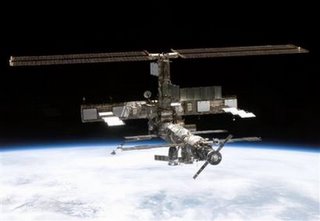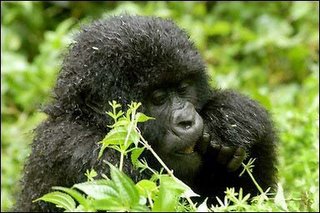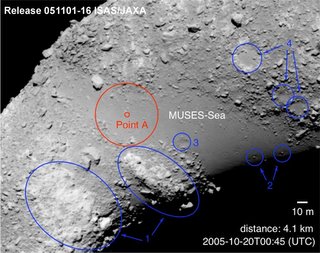NASA are looking to replace the old shuttle fleet and at the same time try to finish the ISS.

"NASA cannot afford to do everything on its plate today," he told the House Science Committee. Funding priorities required the agency to cancel several programs that "we either did not need or did not need right now," Griffin said.
For example, it seemed like putting the cart before the horse to continue life science studies about how people respond to being in space before the agency was sure it could put people back in space, he said.
In addition to life sciences, another affected program is nuclear systems technology, Griffin said.
That program is designed to provide power to an outpost planned for the surface of the moon. But that won't be needed until after 2018, so the work is currently being deferred, he said.
The agency has adopted a "go-as-you-can-pay" approach, Griffin said.
That focus on two primary areas should serve as a warning of potential cuts for the rest of NASA, Rep. Bart Gordon (news, bio, voting record), D-Tenn., commented.
Committee Chairman Sherwood Boehlert, R-N.Y., expressed support for Griffin but added that "NASA cannot use aeronautics and science as a piggy bank to fund human space flight."
Griffin said the next flight of the space shuttle is still planned for spring, adding that while the agency was surprised by problems with the foam insulation on the last flight, a lot has been learned from that.
NASA has been developing the new crew exploration vehicle, which is intended to fly to the moon but also can replace the space shuttle when it goes out of service.
Delaying that work could result in the United States being out of the manned spaceflight business for a few years after the shuttle is retired, at the same time other nations are increasing their space programs, Griffin said.
In addition, he said, NASA is encouraging private industry to submit proposals to carry cargo and crew to the space station.
I guess the old one really isn't working for them any more.
Hayabusa Closes In On Asteroid
JAXA have a craft approaching an asteroid.

Now just a few miles distant from the space rock, the spacecraft is poised for an historic attempt to collect and return a specimen to Earth from such an object. Imagery from Hayabusa is being used by Japanese scientists to target potential touchdown sites on the rocky world.
Hayabusa was rocketed into space from Japan's Kagoshima Space Center on May 9, 2003 and is a project of that country's Institute of Space and Astronautical Science (ISAS), a space science research division arm of the Japan Aerospace Exploration Agency (JAXA). Hayabusa arrived at its exploration target, near Earth asteroid Itokawa, on September 12, propelled there via ion engines and an Earth swing-by to put the probe on a heading toward Itokawa.
JAXA space engineers are readying Hayabusa for a November 4 "rehearsal descent" - a practice run that is expected to verify procedures for a first touchdown of the probe on the asteroid on November 12. A second touchdown of the craft is slated for November 25.
Ground controllers are carefully monitoring onboard fuel reserves to attempt the historic landings.
In addition, loss of two of Hayabusa's reaction wheels - needed to help delicately maneuver the spacecraft - spurred new control strategies to be devised by ground control engineers.
Along with sampling duties, Hayabusa will dispatch a tiny robot onto the space rock that hops about while relaying images.
The ultra-small 1.3 pound (591 grams) device lander is dubbed MINERVA - short for MIcro/Nano Experimental Robot Vehicle for Asteroid. This small hopping robot lander totes along a set of color cameras. Two of the tiny cameras can produce stereo images of the surface conditions at the landing area of MINERVA. A third camera is mounted on the robot to scan more distant regions of the asteroid's surface and can operate while the lander moves from spot to spot.
Hayabusa is a remote sensing mission, plus a lander and a sample return effort. With its cache of asteroid specimens, Hayabusa's return capsule would return to Earth in June 2007, headed for a parachute deployment and landing in the desert of Woomera, Australia.
The samples of Itokawa brought back to Earth by Hayabusa could provide the first direct evidence of the link between asteroids and meteorites, Japanese space scientists point out.
So soon we might get to see what it looks like on an asteroid.
Reality Czech?

Czechs are going to get to watch Gorillas in a 'reality show.
For the next two months, starting on November 7, live webcasts of one male gorilla, two females and a young gorilla at the Prague zoo will be shown on a public radio Internet site with scenes from the daily life of the apes also screened on public television.
"It is a meaningful alternative to "people" reality shows," the zoo said in a statement. Humans would also be given an insight into great ape behavior, added zoo spokesman Vit Kahle on Wednesday.
Viewers will be asked to vote for their favourite gorilla with money raised from text messages directed towards an existing zoo project to help save gorillas in their natural environment, most likely Cameroon.
The prize for the most liked gorilla will be 12 melons, a pun on the Czech slang substitution of melons for zeros when talking about large sums of cash.
The question is, do the other 'loser' Gorillas get paid melons at all? I guess they don't have actors' unions protecting their livelihoods.
A Long Time Coming
They (as in some scientists) found these fossils in 'sexual congress'
The findings were published in the October edition of the Indian journal "Current Science," which said it was the first time that sexual copulation had been discovered in a fossil state, according to the Press Trust of India news agency.
But voyeurs will need a microscope to view the eternal lovers.
The fossils are tiny swarm cells, a stage in the development of the fungus myxomycetes, also known as slime molds.
The cells reproduce by "fusing," Ranjeet Kar of the Birbal Sahni Institute of Palaeobotany in Lucknow reportedly told PTI. Once the cells fuse, long, threadlike appendages known as flagella, are lost, he said.
Finding the fossils in a fused position and with their flagella shed, is evidence that the two cells were having sex, Kar said.
"The sexual organs being delicate and the time of conjugation short lived, it is indeed rare to get this stage in the fossil state," the study said.
The cells were discovered in a 30-foot deep dry well in the state of Madhya Pradesh.
It's not as exciting as two dinosaurs going at it hammer and tongs.


No comments:
Post a Comment